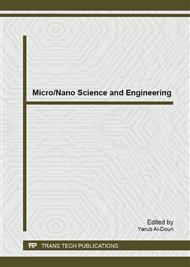p.406
p.411
p.416
p.420
p.428
p.433
p.436
p.442
p.450
A Comparative Study between the Effects of Oxidizing and Reducing Atmospheres on the Properties of ZnO-Bi2O3-Mn2O3 Varistor Fabricated from Micro and Nanoparticles Size of ZnO
Abstract:
Zinc oxide-based varistors are semiconductor ceramics. Their excellent nonlinear electrical behaviors are induced from their grain boundaries and depend on their microstructural characteristics. From a theoretical aspect, finer primary particles with narrow size distributions provide better electrical and optical properties. Thus, these properties are related to the morphology and size of ZnO grains. In this study, ZnO-Bi2O3-Mn2O3 varistors fabricated from ZnO micro-and nanoparticle powders are prepared via conventional ceramic processing. The effects of ZnO particle size and different annealing ambients on the properties of ZnO varistors are also investigated. The strong solid-state reaction during sintering may be attributed to the high surface area of the 20 nm ZnO nanoparticles that promote strong surface reaction. The annealing process also improves grain crystallinity, as shown in the decrease in intrinsic compressive stress based on the X-ray diffraction lattice constant and full-width at half-maximum (FWHM) data. The reduced particle size significantly influences the electrical properties, showing a sharp drop in the breakdown voltage. Thus, the ZnO nanoparticles can be used to manufacture of varistors with superior properties and lower breakdown voltage compared with commercial ones.
Info:
Periodical:
Pages:
428-432
Citation:
Online since:
April 2014
Authors:
Keywords:
Price:
Сopyright:
© 2014 Trans Tech Publications Ltd. All Rights Reserved
Share:
Citation:


